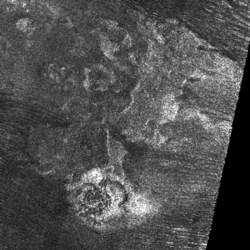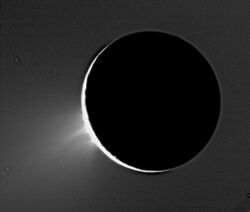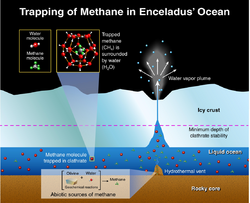Astronomy:Cryovolcano

A cryovolcano (sometimes informally called an ice volcano) is a type of volcano that erupts volatiles such as water, ammonia or methane into an extremely cold environment that is at or below their freezing point. The process of formation is known as cryovolcanism. Collectively called cryomagma, cryolava or ice-volcanic melt, these substances are usually liquids and can form plumes, but can also be in vapour form. After the eruption, cryomagma is expected to condense to a solid form when exposed to very low surrounding temperatures. Cryovolcanoes may potentially form on icy moons and other objects with abundant water past the Solar System's snow line (such as Pluto[2]). A number of features have been identified as possible cryovolcanoes on Pluto, Titan and Ceres, and a subset of domes on Europa may have cryovolcanic origins.[3][4]
One potential energy source on some solar system bodies for melting ice and producing cryovolcanoes is tidal heating.[5]
Signs of past warming of the Kuiper belt object Quaoar[6] have led scientists to speculate that it exhibited cryovolcanism in the past. Radioactive decay could provide the energy necessary for such activity, as cryovolcanoes could emit water mixed with ammonia, which would melt at 180 K (−95 °C) and create an extremely cold liquid that would flow out of the volcano.
Observations
On November 27, 2005, Cassini photographed cryovolcanic plumes on the south pole of Enceladus.[7] (See also: Enceladus (cryovolcanism).)
Indirect evidence of cryovolcanic activity was later observed on several other icy moons of the Solar System, including Europa, Titan, Ganymede, and Miranda. Cassini has observed several features thought to be cryovolcanoes on Titan, notably Doom Mons with adjacent Sotra Patera, a feature regarded as "the very best evidence, by far, for volcanic topography anywhere documented on an icy satellite."[8] Cryovolcanism is one process hypothesized to be a significant source of the methane found in Titan's atmosphere.[9]
In 2007, observations by the Gemini Observatory showing patches of ammonia hydrates and water crystals on the surface of Pluto's moon Charon suggested the presence of active cryovolcanoes or cryogeysers.[10][11] Subsequent observations by New Horizons in 2015 found that Charon has a youthful surface, supporting this idea.[12] Pluto itself has two features that have been identified as possible cryovolcanoes, being mountains with indented peaks.[13]
In 2015, two distinct bright spots inside a crater of the dwarf planet Ceres were imaged by the Dawn spacecraft, leading to speculation about a possible cryovolcanic origin.[14] In September 2016, NASA JPL and NASA Goddard scientists released findings that the large Ahuna Dome on Ceres is a "volcanic dome unlike any seen elsewhere in the solar system. [The large] mountain is likely volcanic in nature. Specifically, it would be a cryovolcano -- a volcano that erupts a liquid made of volatiles such as water, instead of silicates. ... the only known example of a cryovolcano that potentially formed from a salty mud mix, and that formed in the geologically recent past."[15] In addition, at least some of Ceres' well-known bright spots (notably including the ones in Occator crater) are likely also cryovolcanic in origin.[16][17] A study published in March 2017 suggests that Occator's most recent large eruption occurred about 4 million years ago and thus that Ceres may still be active.[18]
See also
- Astronomy:List of extraterrestrial volcanoes
- Earth:Ice volcano – Wave-driven mound of ice formed on terrestrial lakes
- Earth:Pingo – Mound of earth-covered ice
References
- ↑ Lopes, R. M. C.; Kirk, R. L.; Mitchell, K. L.; LeGall, A.; Barnes, J. W.; Hayes, A.; Kargel, J.; Wye, L. et al. (19 March 2013). "Cryovolcanism on Titan: New results from Cassini RADAR and VIMS". Journal of Geophysical Research: Planets 118 (3): 416–435. doi:10.1002/jgre.20062. Bibcode: 2013JGRE..118..416L. https://hal.archives-ouvertes.fr/hal-00807740/file/Lopes_et_al-2013-Journal_of_Geophysical_Research__Planets.pdf.
- ↑ Witze, Alexandra (2015). "Ice volcanoes may dot Pluto's surface". Nature. doi:10.1038/nature.2015.18756. http://www.nature.com/news/icy-volcanoes-may-dot-pluto-s-surface-1.18756.
- ↑ Fagents, Sarah (2003-12-27). "Considerations for Effusive Cryovolcanism on Europa: The Post-Galileo Perspective". Journal of Geophysical Research 108 (E12): 5139. doi:10.1029/2003JE002128. Bibcode: 2003JGRE..108.5139F.
- ↑ Quick, Lynnae C.; Glaze, Lori S.; Baloga, Stephen M. (2017-03-01). "Cryovolcanic Emplacement of Domes on Europa". Icarus 284: 477–488. doi:10.1016/j.icarus.2016.06.029. Bibcode: 2017Icar..284..477Q. https://www.sciencedirect.com/science/article/pii/S0019103516303840.
- ↑ Greenberg, Richard (2002). "Tidal-tectonic processes and their implications for the character of Europa's icy crust" (in en). Reviews of Geophysics 40 (2). doi:10.1029/2000rg000096. ISSN 8755-1209.
- ↑ Jewitt, D.C.; J. Luu (2004). "Crystalline water ice on the Kuiper belt object (50000) Quaoar". Nature 432 (7018): 731–3. doi:10.1038/nature03111. PMID 15592406. Bibcode: 2004Natur.432..731J.. Reprint on Jewitt's site (pdf)
- ↑ Chang, Kenneth (March 12, 2015). "Suddenly, It Seems, Water Is Everywhere in Solar System". The New York Times. https://www.nytimes.com/2015/03/13/science/space/suddenly-it-seems-water-is-everywhere-in-solar-system.html.
- ↑ "Cassini Spots Potential Ice Volcano on Saturn Moon". NASA, December 14, 2010
- ↑ Media Relations Office: Cassini Imaging Central Laboratory For Operations (2009). "Cassini Finds Hydrocarbon Rains May Fill The Lakes". Space Science Institute, Boulder, Colorado. http://ciclops.org/view.php?id=5471&js=1.
- ↑ "Charon: An ice machine in the ultimate deep freeze". July 17, 2007. http://www.spaceflightnow.com/news/n0707/17charon/.
- ↑ Cook et al. (2007). "Near-Infrared Spectroscopy of Charon: Possible Evidence for Cryovolcanism on Kuiper Belt Objects". The Astrophysical Journal 663 (2): 1406–1419. doi:10.1086/518222. Bibcode: 2007ApJ...663.1406C. http://www.iop.org/EJ/article/0004-637X/663/2/1406/70488.html.
- ↑ Beatty, Kelly (2 October 2015). "Charon: Cracked, Cratered, and Colorful". Sky and Telescope. http://www.skyandtelescope.com/astronomy-news/charon-cracked-cratered-and-crazy-100220155/.
- ↑ Witze, A. (2015-11-09). "Icy volcanoes may dot Pluto's surface". Nature News. doi:10.1038/nature.2015.18756. http://www.nature.com/news/icy-volcanoes-may-dot-pluto-s-surface-1.18756. Retrieved 2015-11-09.
- ↑ O'Neill, Ian (25 February 2015). "Ceres' Mystery Bright Dots May Have Volcanic Origin". Discovery Communications. http://news.discovery.com/space/ceres-mystery-bright-dots-may-have-volcanic-origin-150225.htm.
- ↑ "Ceres' Geological Activity, Ice Revealed in New Research". September 1, 2016. Archived from the original on 2016-09-04. https://web.archive.org/web/20160904143615/http://dawn.jpl.nasa.gov/news/news-detail.html?id=6611.
- ↑ Staff (September 5, 2016). "Ceres: The tiny world where volcanoes erupt ice". http://www.spacedaily.com/reports/Ceres_The_tiny_world_where_volcanoes_erupt_ice_999.html.
- ↑ Quick, Lynnae C.; Buczkowski, Debra L.; Ruesch, Ottaviano; Scully, Jennifer E. C.; Castillo-Rogez, Julie; Raymond, Carol A.; Schenk, Paul M.; Sizemore, Hanna G. et al. (2019-03-01). "A Possible Brine Reservoir Beneath Occator Crater: Thermal and Compositional Evolution and Formation of the Cerealia Dome and Vinalia Faculae". Icarus 320: 119–135. doi:10.1016/j.icarus.2018.07.016. Bibcode: 2019Icar..320..119Q. https://www.sciencedirect.com/science/article/pii/S0019103517306371.
- ↑ Grossman, David (March 6, 2017). "The Ice Volcanoes of Ceres Were Highly Active a Few Million Years Ago". Popular Mechanics. http://www.popularmechanics.com/space/solar-system/a25552/ice-volcanoes-ceres-active/.
External links
- Triton - Triton at the eight Planets
- South Pole of Triton - Triton at SolarViews.com
- Enceladus' South Polar Stripes Spew "Warm" Water - News article at the Planetary Society
- Cryovolcanism on Charon and other Kuiper Belt Objects
- Ice Volcanoes of Lake Superior's South Shore
- Dykes, Brett Michael (February 8, 2011). "Ice volcanoes are all the rage this winter: How do you stimulate a regional tourist economy?". The Lookout (Yahoo News). https://news.yahoo.com/s/yblog_thelookout/20110208/ts_yblog_thelookout/ice-volcanoes-are-all-the-rage-this-winter.
- Herzog, Karen (February 6, 2011). "Ice volcanoes attract curious explorers to Lake Michigan shore: Experts warn to explore formations with caution". Journal Sentinel. http://www.jsonline.com/news/milwaukee/115448834.html.
 |






